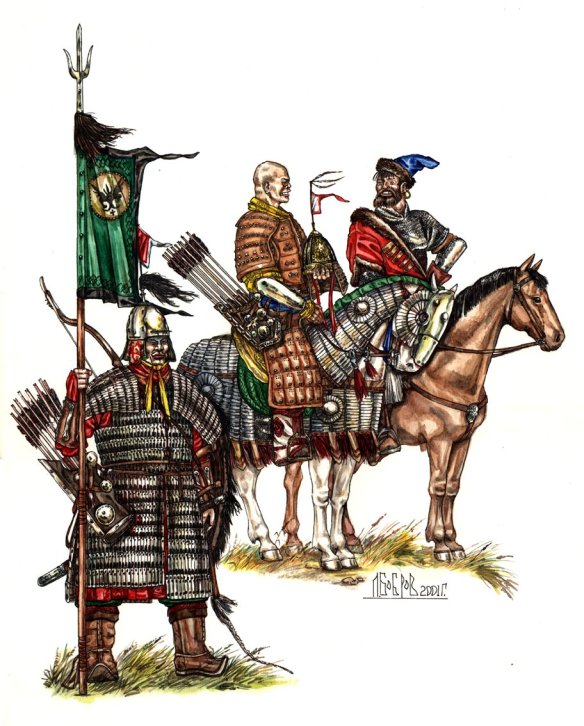About 560 AD a local Tibetan chieftain, Gnam-ri slon mtshan, revolted against his Zan-Zun overlords and established the Yarlung dynasty. By about 630 his successor Sron btsan sgampo had unified the Tibetan clans and founded an empire which over the next two centuries fought expansionist wars. After 841 this broke up, but successor states survived and continued to maintain armies, often fighting each other. The last Yarlung ruler was Rgyal-sras of Tsong-kha, a principality on the border of the Hsi-Hsia state, who died in 1065 Arabs, Chinese and Bengalis were all at various times associated with the Tibetan empire. Tibetan armies in India and west of the Parnirs seem to have been small, and their Ferghanan allies are best regarded as Turks rather than Arabs Combined Tibetan-Chinese armies were usually under Chinese command. The Abbasid troops represent hose captured by the T’ang in 801 thought to have been either taken prisoner by the Tibetans in an otherwise unknown western campaign and incorporated into the army, or failed rebels or dissidents who had voluntarily joined it. They were under Tibetan command. Nepalese and Nan-chao allies cannot be used with each other, nor with any other allies apart from Ch’iang. The exact nature of Nepalese troops is conjectural, but they are described as cavalry. They could be a large majority of a Tibetan-Nepalese force. Tibetan cavalry are described in the T’ang Annals as armed with very long lance, both man and horse completely mailed except for the eyes, and invulnerable to swords and strong bows. There is no suggestion anywhere that they charged at the gallop. The same T’ang source describes them as fighting dismounted and arrayed in ranks. Though bow-armed they favoured close combat. Tibetans were skilled makers of siege equipment.
Later Mongol Influence
After the Mongol Prince Köden took control of the Kokonor region in 1239, in order to investigate the possibility of attacking Song China from the West, he sent his general Doorda Darqan on a reconnaissance mission into Tibet in 1240. During this expedition the Kadampa (Bka’-gdams) monasteries of Rwa-sgreng and Rgyal-lha-khang were burned, and 500 people killed. The death of Ögödei the Mongol Khan in 1241 brought Mongol military activity around the world ground, temporarily, to a halt. Mongol interests in Tibet resumed in 1244 when Prince Köden sent an invitation to Sa-skya Paṇḍita (1182–1251) to come to his capital and formally surrender Tibet to the Mongols. Sa-skya Paṇḍita arrived in Kokonor with his two nephews ‘Phags-pa (1235–80) and Phyag-na Rdo-rje (1239–67) in 1246.
After an internecine feud among the Mongol princes Quibilai was appointed by Möngke Khan to take charge over the Chinese campaigns in 1253. Since Sa-skya Paṇḍita had already died Qubilai took ‘Phags-pa into his camp as a symbol of Tibet’s surrender. Qubilai was elected Qaɣan in 1260 following the death of his brother Möngke, although his ascendance was not uncontested. At that point he named ‘Phags-pa as ‘state preceptor’ Guo-shi. In 1265 ‘Phags-pa returned to Tibet and for the first time made an attempt to impose Sa-skya hegemony with the appointment of Shakya Bzang-po (a long time servant and ally of the Sa-skyas) as the Dpon-chen ‘great administrator’ over Tibet in 1267. A census was conducted in 1268 and Tibet was divided into 13 myriarchies.
In 1269 ‘Phags-pa returned to Kublai’s side at his new capital Qanbaliq (modern day Beijing). He presented the Qaɣan with a new script designed to represent all of the languages of the empire. The next year he was named Di-shi ‘imperial preceptor’, and his position as titular ruler of Tibet (now in the form of its 13 myriarchies) was reconfirmed. The Sa-skya hegemony over Tibet continued into the middle of the 14th century, although it was challenged by a revolt of the ‘Bri-khung sect with the assistance of Hülegü of the Ilkhanate in 1285. The revolt was suppressed in 1290 when the Sa-skyas and eastern Mongols burned ‘Bri-khung and killed 10,000 people (cf. Wylie 1977).
#
The relationship that developed and continued to exist into the 20th Century between the Mongols and Tibetans was a reflection of the close racial, cultural, and especially religious affinity between the two Central Asian peoples. The Mongol Empire was a world empire and, whatever the relationship between its rulers and the Tibetans, the Mongols never integrated the administration of Tibet and China or appended Tibet to China in any manner.
Tibet broke political ties with the Yuan emperor in 1350, before China regained its independence from the Mongols. Not until the 18th Century did Tibet again come under a degree of foreign influence.
